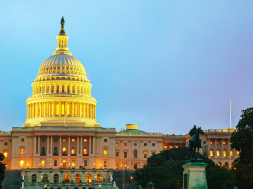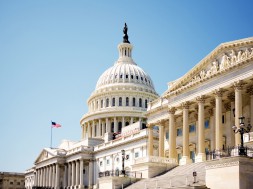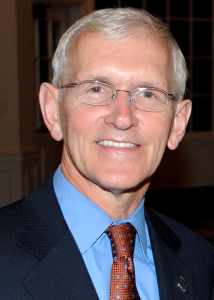
The Higher Education Act and America’s Workforce
By Steve Gunderson, President and CEO, Career Education Colleges and Universities
Recently, I was asked to speak about the history and relationship between the Higher Education Act and America’s workforce. The timing could not have been better. At the moment no HEA Reauthorization proposal was moving through the House or Senate. At the same time the previous week the Wall Street Journal published an article by Sarah Chaney titled, “Jobs Outnumber Seekers by Record Gap.” In the article, she writes, “Some of the slowdown in job growth could reflect a shrinking supply of available workers.” Jeff Wall, chief executive of a Cincinnati-based home-repair service said, “The No. 1 issue our franchisees are having right now is they cannot find enough qualified labor to meet the demands.”
It was a perfect lead-in to understand the state of America’s Workforce Investment Strategy.
Two factors – The Technology Revolution and the Redefinition of Job Preparation – have created our present challenge.
Technology has changed our workplace and our workforce. Since the 1970s and the creation of personal computers, almost every aspect of our work has changed. By the 1980s we were working with the Windows Platform. In the 1990s, we experienced the creation of Wi-Fi and almost universal access. The previous decade was defined by the creation of the smartphone and the present generation is defined by robots and artificial intelligence.
What’s really interesting is to compare this bit of history with higher education enrollments. In 2000, 15.25 million students were enrolled in higher education in America. Ten years later, 21 million students were enrolled.
Opening higher education to all Americans has also impacted the amount of student debt in the country today. In 2000, $55.8 million in federal student loans were issued. Ten years later, $127.7 million in federal student loans were issued. An increase of 7 million in student enrollments resulted in a $70 million annual increase in student loans!
How did this happen?
In 1973, then President Richard Nixon signed into law America’s great Comprehensive Employment and Training Act, known by its initials CETA. Ten years later, President Ronald Reagan signed into law its replacement, the Job Training Partnership Act. As a member of Congress and the House Education Committee at that time, I took great pride in a difficult but bi-partisan agreement that changed workforce investment.
In doing so, we first limited the “training program” to three specific constituencies; 1) welfare recipients; 2) disadvantaged youth; and 3) displaced workers. The federal government’s focus on training was aimed at three at-risk populations. At the same time, the technology revolution began to change how Americans prepared for work. More and more jobs required some level of postsecondary education. Today, 65 percent of all jobs and 85 percent of all new jobs require some postsecondary education credential.
By accident or design, the Higher Education Act became America’s workforce investment strategy! The numbers prove this dramatic change. Consider the dramatic disparity in federal funding for four key workforce programs:
- Perkins Vocational Education Act: $1.1 Billion
- Workforce Investment Opportunity Act (Today’s version of JTPA): $3.3 Billion
- The Post 9/11 GI Benefits: $4.8 Billion
- The Higher Education Act: $125 Billion
But it’s not about just a BA Degree!
In retrospect, our universal effort to convince everyone to go to college mistakenly told them they needed to complete a four-year degree. And we still make this mistake. Just recently, Smart Asset using 2018 Census Bureau data showed the value of a 4-year BA Degree with the following projections for average annual income based upon education attainment:
| High school, no college | $35,256 |
| Some college/no degree | $38,376 |
| AA degree | $41,496 |
| BA degree | $59,124 |
What such numbers ignore is that the traditional blue-collar worker has been replaced by a skilled career professional. Consider these Census Bureau Incomes. The average income for an aircraft technician is $63,000 with the top 10 percent earning $98,000. The average income of an HVAC technician is $47,000, with the top 10 percent earning $76,000 or more. The average income of a Dental Hygienist is $74,000, with the top 10 percent earning over $100,000.
Recently, at our association’s annual convention, Carolyn Lee of the Manufacturing Institute said, “The number one concern of employers in the manufacturing sector today is not regulations, trade or taxes. It is the skills gap and the ability to hire qualified employees. The Georgetown Center for Education and the Workforce just published a new study looking at employment in America’s manufacturing sector. Between 2017 – 2027, workers with just a high school diploma will decrease by 200,000. At the same time, workers with a BA Degree will also decrease by 200,000. But employers with mid-level career skills will increase by 300,000!
The challenges moving forward
Thanks to growth and the retiring baby-boom generation, we need 38.7 million new workers by 2026. That should tell us there is more than enough demand for students in every sector of higher education. Such numbers don’t include the growing demand for short-term continuing education required to keep up with the pace of skill demands in one’s chosen occupation.
My sector’s postsecondary career education schools project a demand for 4.6 million new workers in just the top 21 occupations we serve.
Meeting this challenge would never be easy. It has become more difficult by two parallel facts. First, there has been a decade-long ideological attack on taxpaying career schools. Because too many large private online schools created an era of bad outcomes, the entire sector has become the target of those seeking to eliminate even multi-generation family-owned and operated schools. Our two-year and less schools have a 67 percent completion rate – far higher than any other two-year system. But the war continues, and over 800 such schools have closed since 2010.
At the same time, no less than 24 states have moved to some form of free college now. While each state’s program has a different set of restrictions, the net effect has been a gradual transition for many of the nation’s community colleges to 2-year liberal arts preparatory schools enabling the students to complete their BA degree at one of the state’s 4-year colleges.
At the same time, the growing polarization of America’s politics in Washington has prevented any modernization of the Higher Education Act. We have a modern, diversified student body. We have equipped our schools with the most modern academic delivery tools. But public policy continues to limp along on a ten-year-old law. For example, short-term programs designed to upgrade our current workforce’s skills are not yet eligible for short-term Pell Grants to enable low-income people to keep pace with changes in technology.
Seeking common ground for progress
To create a modern, bi-partisan higher education policy we would all do well to step back and consider the current higher education environment. Yes, we have $1.5 trillion in total student debt. But we also have 44.7 million Americans with some level of debt. This means the average debt for all Americans is $32,731. While high, such numbers do not cripple the economy. Consider that most graduate degrees carry student debt over $100,000, and the average debt at our 2-year career schools is less than $9,000. For most college graduates, their debt is actually a manageable item in their personal finances.
A bigger misunderstanding is to define higher education by tradition. Yes, our large land-grant colleges and universities will always be the nation’s image of higher education. And because of their size, they serve more students than any other sector of higher education. But today, despite all the recent closings in the sector there are still more 2-year taxpaying career colleges than all the nation’s 2-year and 4-year public institutions combined. Certainly, our nation’s 6,600 colleges are different. But we’d be wise to recognize the diversity of size, shape and mission for all these schools.
At a minimum, let’s stop the wars seeking to destroy those offering mid-level career skills to a nation desperately seeking such skilled professionals.
This gets to the diverse roles for higher education today; and how public policy must respond. Most of us continue strong support for our nation’s land grant and research institutions. In so many ways they have contributed to the nation’s scientific and academic progress. Our nation’s non-profit colleges and universities lift up both a religious and a cultural commitment to liberal arts education. The nation’s community colleges continue to provide access to postsecondary education at home – wherever that home might be. As the home-town school, they are destined to serve many missions and many masters. The most recent mission is to host the emerging 2-years of free college made available (by different terms in different states) in 24 states.
But since Benjamin Franklin’s first career school in 1749, the nation’s career schools have long been multi-generation, family-owned schools serving the skill needs of a given community or region. When Congress lifted the cap on the percent of a school’s students who could engage in online learning, a new phenomenon of large publicly-traded online schools emerged. But the students they attracted were not equipped to complete 4-year online liberal arts programs. Life got in the way. The outcomes were poor. And it caused a wave of bad reputations for the entire sector.
Today, the sector has significantly returned to its historic mission – postsecondary career education. As a result, its outcomes – especially for those students, programs and schools focused on campus-based delivery of academics – match or exceed those in any other sector.
But the war against students seeking postsecondary career education might be one of the nation’s most important wars. And it’s not a question of whether schools survive. The key question is whether the students these schools serve will have access to the programs they seek for the careers they desire.
There is no better example of this challenge than recent efforts in Congress to change the current 90/10 ratio rule. This rule was created to say that no school should get more than 90 percent of its revenues from Title IV programs. That might have made sense when colleges only served primarily upper-middle-class students seeking liberal arts degrees. It makes no sense today when a much larger part of the general population (which includes lower-income students) are seeking postsecondary education.
But the sector’s opponents continue to seek ways to oppose the sector’s very existence. So, they are now proposing that such a ratio should also include not only Title IV financial aid; but also the GI benefits used by veterans. And that the ratio should be reduced to 85/15 or even lower.
There are three problems with such proposals – beyond the basic academic elitism they project.
First, every service member was promised a GI Benefit for their military service. They earned this benefit, it is not an economic subsidy. And they have the right to choose where to use it.
Second, this provision became public law when the government guaranteed private loans. But in 2010, during the Obama Administration, the government took over direct lending of student loans. Were the government still guaranteeing loans rather than issuing them, almost no school would be at risk of failing a 90/10 ratio.
Third, but equally important, many veterans do not want a liberal arts degree! They went into the military right out of high school because they did not want a traditional education. During their time in the military, they were exposed to and learned basic skills in a given career. Now they seek the education and career credentials that would enable them to seek full-time employment in their chosen field.
The programs our schools offer are not available at traditional colleges and universities. And if available at a community college, the waiting list to access the courses needed extends the student’s time in school beyond what they can complete in our sector’s schools.
If such a proposal were to become law, recent research by NDP Analytics shows that 158,000 veterans would lose access to the career programs they seek. And schools that are located in areas with both a large low-income population seeking career skills and a large veterans population seeking career credentials would fail the new test. Projections are that 266 schools would fail such a test – not because they have bad programs or outcomes, but because they happen to serve a low-income population and a large veterans population. It may represent the worst possible public policy in higher education in decades.
Can we find common ground?
Despite the polarized politics of Washington today, a quiet revolution is beginning which can protect students and taxpayers. In the President’s Executive Order on College Free Speech, he also included a provision requiring that all programs at all schools must disclose minimum outcome metrics for income and debt after completion of such programs. Later this year, the Department of Education is expected to formally replace the controversial Gainful Employment Rule with a specific set of outcome metrics for all programs at all schools. During the current debate about veterans’ use of the earned GI Benefit, we have suggested that any programs serving veterans under the GI benefit should be required to disclose such metrics as retention; completion; time to completion; placement in field of study; debt; and income five years after graduation.
We all accept that there are good and bad schools. More importantly, there are good and bad programs at all schools. Our public policy goal should be to establish a common set of outcome metrics for all programs at all schools. Then, if it is a bad program every school has two choices; fix it or end it!
Tony Carnevale, a Labor Economist with the Clinton Administration created and leads the Georgetown Center for Education and the Workforce. Looking at this quiet movement towards a common set of program-specific outcome metrics, he wrote:
“The focus on programs rather than institutions could finally break the cost curve in higher education. By providing students what they need without all the extras, we could chip away at waste, duplication and misplaced incentives that now animate higher education.
Future American workers are facing an exciting yet withering journey to keep pace with change. The American higher education system is going to have to change far more than it has so far dared if it is an active helper to those workers, rather than a structural hindrance to them.”
There is hope, indeed. We can bring higher education and workforce preparation into a common partnership. But it will require good and noble efforts by the leaders in both political parties to set aside the debates of yesterday and create the public policies that best serve tomorrow.
STEVE GUNDERSON’S entire career has held the issues of education and workforce investment as priorities for both the nation and his professional work. Today, he advances this work as the President and CEO of the Association of Career Education Colleges and Universities (CECU).
His commitment began at the age of 23, when he was first elected to the Wisconsin State Legislature. After three terms in Madison, Gunderson served 16 years in the U.S. Congress and was a recognized leader on agriculture, education, employment policy, health care and human rights issues. Following his career in public service, he was named the senior consultant and managing director of the Washington office of The Greystone Group, a strategic management and communications consulting firm. His portfolio centered around research, writing, speaking and consulting on the jobs revolution in America. He was the lead author of a book on this subject, The Jobs Revolution: Changing How America Works and published “The New Middle Class: Creating Wealth, Wages and Opportunity in the 21st century.
Gunderson served as President and CEO of the Council on Foundations between 2005 and 2011. One of his many priorities at the Council was education and workforce investment. Under his leadership the Council has created a division for Public-Private Partnerships including the National Fund for Workforce Solutions.
In 2012 Steve became President and CEO of the Association of Private Sector Colleges and Universities. Under his leadership, he has worked to refocus the association and the sector on workforce education programming. He has become a strong voice for postsecondary career education, writing and speaking on this topic across the nation. He is still recognized for his insight and analysis on the national political issues of the day, and has lectured widely from Harvard University to The Brookings Institution.
A graduate from the University of Wisconsin – Madison and the Brown School of Broadcasting, Gunderson and his husband, Ethan Ngo, live in Arlington, Virginia. He is an active member of Redeemer Lutheran Church and today serves on the Board of Directors of Lutheran World Relief. He has previously served on a wide range of non-profit boards including The White House Fellows Selection Commission, The Lutheran Theological Seminary at Gettysburg and the Human Rights Campaign.
Contact Information: Steve Gunderson // President and CEO // Career Education Colleges and Universities // president@career.org // https://www.career.org











